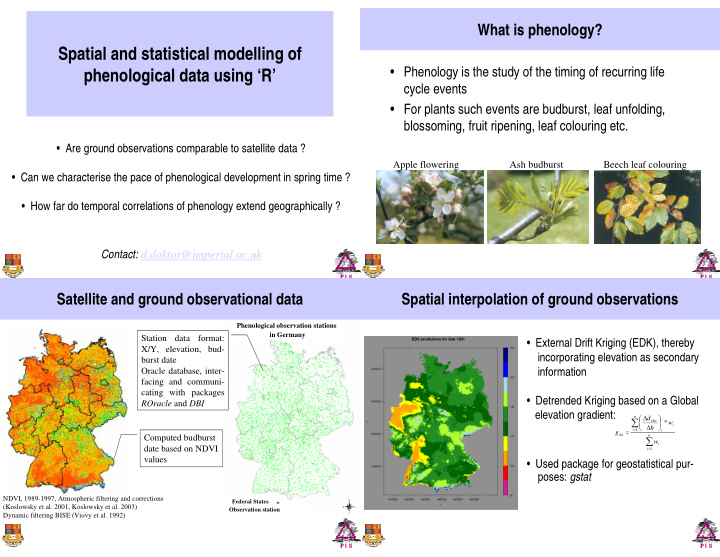



What is phenology? Spatial and statistical modelling of • Phenology is the study of the timing of recurring life phenological data using ‘R’ cycle events • For plants such events are budburst, leaf unfolding, blossoming, fruit ripening, leaf colouring etc. • Are ground observations comparable to satellite data ? Apple flowering Ash budburst Beech leaf colouring • Can we characterise the pace of phenological development in spring time ? • How far do temporal correlations of phenology extend geographically ? Doktor, D, Imperial College London Contact: d.doktor@imperial.ac.uk Satellite and ground observational data Spatial interpolation of ground observations Phenological observation stations in Germany Station data format: • External Drift Kriging (EDK), thereby X/Y, elevation, bud- incorporating elevation as secondary burst date information Oracle database, inter- facing and communi- cating with packages • Detrended Kriging based on a Global ROracle and DBI elevation gradient: ∆ ⎛ ⎞ n ∑ d ⎜ ⎟ obs * w ∆ i ⎝ ⎠ h = = i 1 i g ha Computed budburst n ∑ w i date based on NDVI = i 1 values • Used package for geostatistical pur- poses: gstat NDVI, 1989-1997, Atmospheric filtering and corrections Federal States (Koslowsky et al. 2001, Koslowsky et al. 2003) Observation station Dynamic filtering BISE (Viovy et al. 1992)
Crossvalidation of interpolation methods EDK vs NDVI Selected NDVI-pixels for comparison buffered by deciduous forest according to CORINE ⇒ The obtained subset contains only a fraction of the original information (~0.02 %) Results: - Mean difference of 3.3 days for 1989-1997 - Satellite derived green-up preceded ground observations - Average correlation coefficient r = 0.38 • Both interpolation techniques are of nearly the same quality Problem: - Heterogeneity in vegetation cover affects ( green =EDK, red =Detrended Kriging) NDVI-signal • The mean MAE is about 5 days for each species and method Gaussian Mixture Models Optimisation algorithm Frequency distributions of p ,..., p ( ) ( ) ( ) positive numbers summing to one observations of Oak ( green = + + 1 m f x p f x ... p f x ( ) ( ) m 1 1 n n line) modelled using between the component densities f x ,..., f x 1 m 1-4 Mixture distributions Different modelling approaches: orange = 1 component(s) - Optimisation algorithm => ‘base’ blue = 2 “” red = 3 “” Akaike’s Information Criterion (AIC) based on chi-square black = 4 “” at 0.05 significance level - Clustering via EM-algorithm => package ‘mclust’ µ 1 µ 2 µ 3 µ 4 σ 1 σ 2 σ 3 σ 4 ω 1 ω 2 ω 3 ω 4 Bayesian Information Criterion (BIC) 1979 134.95 6.78 1 1980 132.09 135.33 11.86 4.70 0.67 0.33 1981 104.54 116.31 131.55 137.51 2.94 11.34 3.83 6.78 0.15 0.37 0.32 0.16 1982 128.15 135.14 10.68 3.78 0.62 0.38
EM algorithm Space-time correlations of ground observations - Time series’ correlation of station pairs is assigned to distance categories Differences in number of 1 2 3 4 5 6 7 8 9 10 11 0-25, 25-50, 50-100, 100-200, 200-300, 300-400, 400-500, 500-600, 600-700, 700-800, 800-900 [km] detected Gaussian Mixtu- res and their charac- - Years are only chosen terising values when both stations have observed Permutation of the order Results: and changing of initial • Low correlations for stations with at least 50 observed years values had no effect on the r=0.45 outcome of EM-algorithm • For years with a unimodal distributions r=0.65 after Koenig et al. (1998) Detecting stations with reversed trends Conclusions Solid interpolation methodologies allow the comparison of ground and - Focus on single stations satellite observations. Due to heterogeneity of ground vegetation with negative correlations correlations between the two are weaker than expected. over all distance categories - Detection of reversed The pace of phenological development can be characterised trends when their annual quantitatively using Gaussian Mixtures. Between 1-4 mixtures could be observations are compared identified reflecting strongly variable weather patterns during spring to the Grand Mean time. Origin of reversed trends? Temporal correlations of phenological data extend over relatively large distances. The correlation’s magnitude depends on weather patterns • Change in immediate environment of observed experienced within each analysed year. species (microclimate) • Falsely recorded phenological phases
Recommend
More recommend